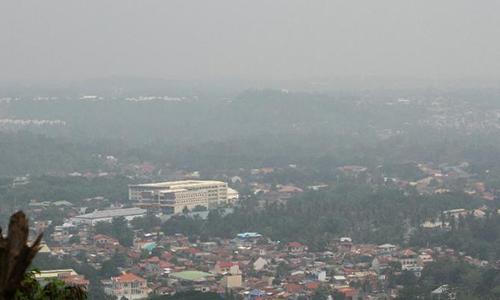Indonesian haze reaches the Philippines
Haze from Indonesian forest fires has spread to the southern and central Philippines, disrupting air traffic and prompting warnings for residents to wear face masks, authorities said Friday.
The large southern Philippine island of Mindanao is more than 1,200 kilometres (745 miles) from the nearest fires but the haze has become a worsening problem across the island over the past week, aviation authorities said.
It spread to the country's central islands of Cebu and Negros on Friday, disrupting air traffic, Civil Aviation Authority of the Philippines spokesman Eric Apolonio said.
Eight domestic flights have been cancelled and dozens delayed since the problem began on October 16, affecting thousands of passengers, he added.
On some occasions, pilots could not see the airstrip as they were coming in to land.
"If you cannot see the runway it is very dangerous. You cannot always depend on instruments," he reportedly said.
Dense haze hung over Davao, Mindanao's largest city of 1.5 million people, on Friday afternoon, plunging it under an early twilight.
Its airport, one of those affected according to Apolonio, handles 48 flights a day.
With visibility down to 1.2 kilometres at some times during the day, far less than the usual 10 kilometres, aircraft are forced to circle and wait above the runways for up to an hour, according to Apolonio.
Apolonio said the flight delays were also disrupting the busy airport of capital Manila, with some Mindanao-bound flights being held back.
Because Manila airport is operating at its full capacity of 40 landings and take-offs per hour, any delay involving Mindanao flights disrupts the aircraft queue for the rest of the day, he added.
For nearly two months, dense haze produced by Indonesian slash-and-burn farmers have suffocated vast expanses of Southeast Asia.
This has caused rates of respiratory illnesses to soar, schools to close, and scores of flights and some international events to be cancelled.
Much of the burning is in peatlands being drained and cleared at a rapid rate to make way for agriculture.
The Philippines has not been badly impacted.
It may have worsened recently due to Typhoon Koppu, which hit the northern Philippines on October 18, drawing the haze towards it, state weather forecaster Manny Mendoza reportedly told to the media.
While the seasonal northeast monsoons are expected to push back some of the haze from Indonesia over the coming weeks, any storms hitting the Philippines the rest of the year could aggravate the problem, he said.
"We can't say at this point that the smoke and haze will go away soon. This is expected to continue," Mendoza said.
The haze was not so bad as to raise a medical alarm, but residents in affected areas are being advised to wear face masks, according to health department spokesman Lyndon Lee Suy.
"The content (of the smoke) is not that much but even small amounts of ash could trigger an asthma attack, or cardio-pulmonary obstructive disease," he reportedly said.
Related Posts

